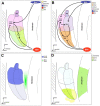A symphony of inner ear developmental control genes
- PMID: 20637105
- PMCID: PMC2915946
- DOI: 10.1186/1471-2156-11-68
A symphony of inner ear developmental control genes
Abstract
The inner ear is one of the most complex and detailed organs in the vertebrate body and provides us with the priceless ability to hear and perceive linear and angular acceleration (hence maintain balance). The development and morphogenesis of the inner ear from an ectodermal thickening into distinct auditory and vestibular components depends upon precise temporally and spatially coordinated gene expression patterns and well orchestrated signaling cascades within the otic vesicle and upon cellular movements and interactions with surrounding tissues. Gene loss of function analysis in mice has identified homeobox genes along with other transcription and secreted factors as crucial regulators of inner ear morphogenesis and development. While otic induction seems dependent upon fibroblast growth factors, morphogenesis of the otic vesicle into the distinct vestibular and auditory components appears to be clearly dependent upon the activities of a number of homeobox transcription factors. The Pax2 paired-homeobox gene is crucial for the specification of the ventral otic vesicle derived auditory structures and the Dlx5 and Dlx6 homeobox genes play a major role in specification of the dorsally derived vestibular structures. Some Micro RNAs have also been recently identified which play a crucial role in the inner ear formation.
Figures




References
-
- Sando I, Orita Y, Miura M, Balaban CD. Vestibular abnormalities in congenital disorders. Ann N Y Acad Sci. 2001;942:15–24. - PubMed
Publication types
MeSH terms
Substances
LinkOut - more resources
Full Text Sources
Other Literature Sources
Research Materials

